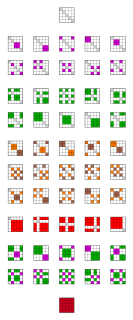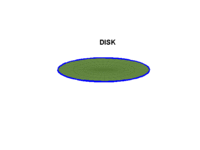| Look up quotient in Wiktionary, the free dictionary. |
Quotient is the result of division in mathematics.
Quotient may also refer to:
| Look up quotient in Wiktionary, the free dictionary. |
Quotient is the result of division in mathematics.
Quotient may also refer to:
| This disambiguation page lists mathematics articles associated with the same title. If an internal link led you here, you may wish to change the link to point directly to the intended article. |

In mathematics, an equivalence relation is a binary relation that is reflexive, symmetric and transitive. The relation "is equal to" is the canonical example of an equivalence relation, where for any objects a, b, and c:

In mathematics, when the elements of some set S have a notion of equivalence defined on them, then one may naturally split the set S into equivalence classes. These equivalence classes are constructed so that elements a and b belong to the same equivalence class if and only if they are equivalent.
In algebra, a homomorphism is a structure-preserving map between two algebraic structures of the same type. The word homomorphism comes from the ancient Greek language: ὁμός (homos) meaning "same" and μορφή (morphe) meaning "form" or "shape". However, the word was apparently introduced to mathematics due to a (mis)translation of German ähnlich meaning "similar" to ὁμός meaning "same". The term "homomorphism" appeared as early as 1892, when it was attributed to the German mathematician Felix Klein (1849–1925).
In algebra, the kernel of a homomorphism is generally the inverse image of 0. An important special case is the kernel of a linear map. The kernel of a matrix, also called the null space, is the kernel of the linear map defined by the matrix.
In abstract algebra, a congruence relation is an equivalence relation on an algebraic structure that is compatible with the structure in the sense that algebraic operations done with equivalent elements will yield equivalent elements. Every congruence relation has a corresponding quotient structure, whose elements are the equivalence classes for the relation.

In topology and related areas of mathematics, the quotient space of a topological space under a given equivalence relation is a new topological space constructed by endowing the quotient set of the original topological space with the quotient topology, that is, with the finest topology that makes continuous the canonical projection map. In other words, a subset of a quotient space is open if and only if its preimage under the canonical projection map is open in the original topological space.
In mathematics, a quotient algebra is the result of partitioning the elements of an algebraic structure using a congruence relation. Quotient algebras are also called factor algebras. Here, the congruence relation must be an equivalence relation that is additionally compatible with all the operations of the algebra, in the formal sense described below. Its equivalence classes partition the elements of the given algebraic structure. The quotient algebra has these classes as its elements, and the compatibility conditions are used to give the classes an algebraic structure.
In set theory, the kernel of a function f may be taken to be either
In algebra, given a module and a submodule, one can construct their quotient module. This construction, described below, is very similar to that of a quotient vector space. It differs from analogous quotient constructions of rings and groups by the fact that in these cases, the subspace that is used for defining the quotient is not of the same nature as the ambient space.
In category theory, a coequalizer is a generalization of a quotient by an equivalence relation to objects in an arbitrary category. It is the categorical construction dual to the equalizer.
In category theory, a branch of mathematics, a subobject is, roughly speaking, an object that sits inside another object in the same category. The notion is a generalization of concepts such as subsets from set theory, subgroups from group theory, and subspaces from topology. Since the detailed structure of objects is immaterial in category theory, the definition of subobject relies on a morphism that describes how one object sits inside another, rather than relying on the use of elements.
In linear algebra, the quotient of a vector space V by a subspace N is a vector space obtained by "collapsing" N to zero. The space obtained is called a quotient space and is denoted V/N.
In mathematics, a pointed space is a topological space with a distinguished point, the basepoint. The distinguished point is just simply one particular point, picked out from the space, and given a name, such as x0, that remains unchanged during subsequent discussion, and is kept track of during all operations.
In mathematics, algebraic spaces form a generalization of the schemes of algebraic geometry, introduced by Artin for use in deformation theory. Intuitively, schemes are given by gluing together affine schemes using the Zariski topology, while algebraic spaces are given by gluing together affine schemes using the finer étale topology. Alternatively one can think of schemes as being locally isomorphic to affine schemes in the Zariski topology, while algebraic spaces are locally isomorphic to affine schemes in the étale topology.
In mathematics, a quotient category is a category obtained from another one by identifying sets of morphisms. Formally, it is a quotient object in the category of categories, analogous to a quotient group or quotient space, but in the categorical setting.
In homological algebra in mathematics, the homotopy categoryK(A) of chain complexes in an additive category A is a framework for working with chain homotopies and homotopy equivalences. It lies intermediate between the category of chain complexes Kom(A) of A and the derived category D(A) of A when A is abelian; unlike the former it is a triangulated category, and unlike the latter its formation does not require that A is abelian. Philosophically, while D(A) makes isomorphisms of any maps of complexes that are quasi-isomorphisms in Kom(A), K(A) does so only for those that are quasi-isomorphisms for a "good reason", namely actually having an inverse up to homotopy equivalence. Thus, K(A) is more understandable than D(A).
In mathematics, a canonical map, also called a natural map, is a map or morphism between objects that arises naturally from the definition or the construction of the objects. In general, it is the map which preserves the widest amount of structure, and it tends to be unique. In the rare cases where latitude in choices remains, the map is either conventionally agreed upon to be the most useful for further analysis, or sometimes the most elegant map known up to date.
In type theory, a kind of foundation of mathematics, a quotient type is an algebraic data type that represents a type whose equality relation has been redefined by a given equivalence relation such that the elements of the type are partitioned into a set of equivalence classes whose cardinality is less than or equal to that of the base type. Just as product types and sum types are analogous to the cartesian product and disjoint sum of abstract algebraic structures, quotient types reflect the concept of set-theoretic quotients, sets whose elements are surjectively partitioned into equivalence classes by a given equivalence relation on the set. Algebraic structures whose underlying set is a quotient are also termed quotients. Examples of such quotient structures include quotient sets, groups, rings, categories and, in topology, quotient spaces. For example, , the rational numbers, is the quotient ring – or "field of fractions" – of , the integers.
In mathematics, given a category C, a quotient of an object Xby an equivalence relation is a coequalizer for the pair of maps